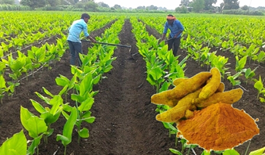

27th November 2023 (11 Topics)
Context:
Turmeric used to be a Poll issue in Nizamabad District of Telengana (2014 and 2018 Assembly elections and 2019 General Election). Formation of Board announced by PM.
National Turmeric Board Overview:
- Legal Status: The National Turmeric Board operates as a non-statutory body.
- Administrative Oversight: It falls under the purview of the Ministry of Commerce & Industry.
- Board Composition:
- Chairperson: Appointed by the Central Government, responsible for providing strategic direction to the Board's activities.
- Secretary: Appointed by the Department of Commerce, responsible for the day-to-day administration of the Board.
- Board Members:
- Ministry Representatives: Officials from the Ministry of AYUSH, Departments of Pharmaceuticals, Agriculture & Farmers Welfare, Commerce & Industry of the Union Government to offer governmental perspectives.
- State Government Representatives: Senior officials from three states on a rotational basis to ensure regional considerations.
- Research and Industry Experts: Representatives from select national/state institutions involved in turmeric research and industry.
- Turmeric Stakeholders: Representatives from turmeric farmers and exporters to advocate for the community's interests.
Objectives of the National Turmeric Board:
- Increasing Awareness and Consumption: Initiate awareness campaigns promoting the health benefits of turmeric to elevate its consumption within India.
- Collaborate with the Ministry of AYUSH to encourage the use of turmeric in traditional medicine systems like Ayurveda.
- Developing International Markets: Conduct market research to identify potential international markets for turmeric and its products.
- Facilitate Indian turmeric exporters' participation in international trade fairs and exhibitions.
- Collaborate with the Ministry of Commerce & Industry to negotiate favorable trade agreements benefiting turmeric exports.
- Research and Development: Invest in research and development to create new turmeric-based products, exploring both culinary and medicinal applications.
- Document and preserve traditional knowledge related to turmeric for future generations, ensuring ethical use.
- Capacity Building and Skill Development: Organize training programs for turmeric growers, emphasizing modern cultivation techniques, sustainable farming practices, and post-harvest handling.
- Provide workshops to enhance farmers' skills in areas such as organic farming, pest management, and irrigation practices.
- Ensuring Quality and Food Safety: Develop and enforce quality standards for turmeric and its products to comply with international regulations.
- Implement food safety measures across the turmeric supply chain to ensure products meet high-quality standards.

About Turmeric Cultivation in India:
- Turmeric (Curcuma longa): A perennial herbaceous plant belonging to the ginger family, turmeric has been utilized for various purposes such as spice, dye, medicine, and religious ceremonies since ancient times.
- Cultivation Conditions: Turmeric thrives in temperatures between 20 and 30 °C (68 and 86 °F) and requires a substantial annual rainfall for optimal growth.
- Leading Global Producer: India holds the position of the world's largest producer and exporter of turmeric, covering approximately 6% of the total area dedicated to spices and condiments in the country.
- Top Producer States: In 2018, Telangana emerged as the leading turmeric producer in India, followed by Maharashtra and Tamil Nadu.
- Color Significance: The vibrant colour of turmeric primarily comes from curcumin, a bright yellow phenolic compound known for its potential anticancer properties. Consequently, there is an increased demand for turmeric with high curcumin content.


